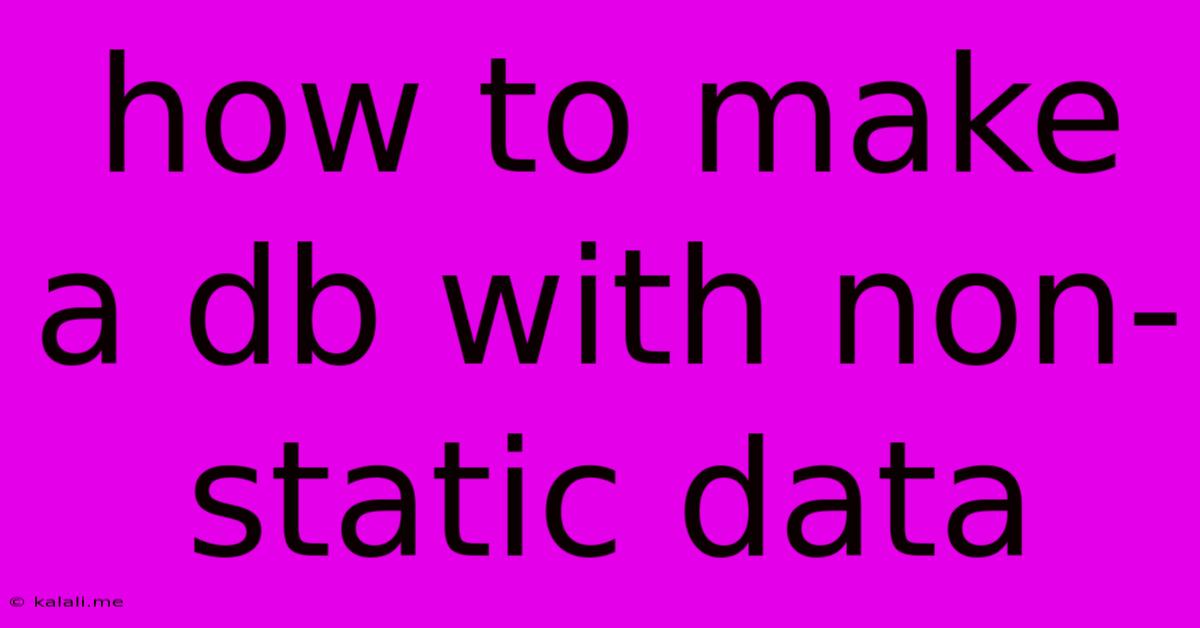How To Make A Db With Non-static Data
Kalali
May 30, 2025 · 3 min read

Table of Contents
How to Create a Database with Non-Static Data: A Comprehensive Guide
Creating a database that handles non-static data – data that changes frequently – requires a different approach than managing static data. This guide will walk you through the process, covering database choices, data modeling techniques, and best practices for ensuring data integrity and efficiency. Whether you're building a simple application or a complex system, understanding these concepts is crucial for success.
This article will cover various aspects of database design for non-static data, from choosing the right database management system (DBMS) to implementing efficient update strategies. We'll also discuss techniques for handling data consistency and concurrency.
Choosing the Right Database Management System (DBMS)
The first step is selecting the appropriate DBMS. The best choice depends on your specific needs and the nature of your non-static data. Here are a few popular options:
-
Relational Databases (RDBMS): Such as MySQL, PostgreSQL, and SQL Server, are well-suited for structured data and offer robust features for managing relationships between data points. They provide excellent data integrity and are a good choice for applications requiring ACID properties (Atomicity, Consistency, Isolation, Durability). These are great for applications with well-defined schemas.
-
NoSQL Databases: These databases are designed for handling large volumes of unstructured or semi-structured data and offer greater scalability and flexibility. Popular choices include MongoDB (document database), Cassandra (wide-column store), and Redis (in-memory data structure store). NoSQL databases are often preferred for applications needing high availability and horizontal scalability. They are less rigid than RDBMS and can handle evolving data structures more easily.
-
Cloud-Based Databases: Services like AWS DynamoDB, Google Cloud Spanner, and Azure Cosmos DB provide managed database solutions, offering scalability, reliability, and ease of management. They often integrate seamlessly with other cloud services.
The choice between RDBMS and NoSQL depends heavily on your application's requirements. Consider factors like data structure, scalability needs, transaction requirements, and the complexity of data relationships.
Data Modeling for Non-Static Data
Effective data modeling is critical for managing non-static data. Consider these strategies:
-
Normalization: For RDBMS, normalization helps reduce data redundancy and improve data integrity. However, be mindful of the trade-offs; higher normalization levels can lead to more complex queries.
-
Schema-less Design (NoSQL): NoSQL databases often employ schema-less designs, allowing data structures to evolve over time without requiring major schema changes. This is particularly beneficial for applications with frequently changing data requirements.
-
Versioning: For tracking changes over time, implementing versioning mechanisms is crucial. This allows you to revert to previous states if necessary and audit data modifications. Consider using timestamps or dedicated version numbers in your database schema.
Handling Data Updates Efficiently
Efficiently updating non-static data is key to performance. Consider these techniques:
-
Batch Updates: For large-scale updates, batch processing can significantly improve performance compared to individual updates.
-
Triggers and Stored Procedures (RDBMS): These automate data updates and enforce data consistency rules.
-
Change Data Capture (CDC): CDC techniques track changes made to the database and allow for efficient replication or processing of these changes.
-
Caching: Caching frequently accessed data can drastically reduce database load and improve response times.
Ensuring Data Integrity and Consistency
Data integrity is paramount when dealing with non-static data. Employ these strategies:
-
Constraints (RDBMS): Use constraints like
UNIQUE,NOT NULL,CHECKto enforce data validation rules. -
Transactions (RDBMS): Transactions ensure that data modifications are atomic and consistent, preventing partial updates.
-
Data Validation: Implement data validation at multiple layers (application, database) to prevent incorrect data from entering the system.
-
Regular Backups: Implement a robust backup and recovery strategy to protect against data loss.
Conclusion
Managing non-static data effectively requires careful planning and a solid understanding of database technologies. By choosing the right DBMS, employing appropriate data modeling techniques, and implementing efficient update and validation strategies, you can build robust and scalable applications that handle dynamic data effectively. Remember to always prioritize data integrity and consider the long-term scalability of your solution.
Latest Posts
Latest Posts
-
Linux Sed Replace String In File
May 31, 2025
-
How To Allow Bad Names In Ubuntu Terminal
May 31, 2025
-
How To Get Rid Of Moss On A Brick Patio
May 31, 2025
-
Do Masters Have Major And Minor
May 31, 2025
-
How To Neutralize Urine Smell In Carpet
May 31, 2025
Related Post
Thank you for visiting our website which covers about How To Make A Db With Non-static Data . We hope the information provided has been useful to you. Feel free to contact us if you have any questions or need further assistance. See you next time and don't miss to bookmark.